Retail Industry Digital Transformation Market Size
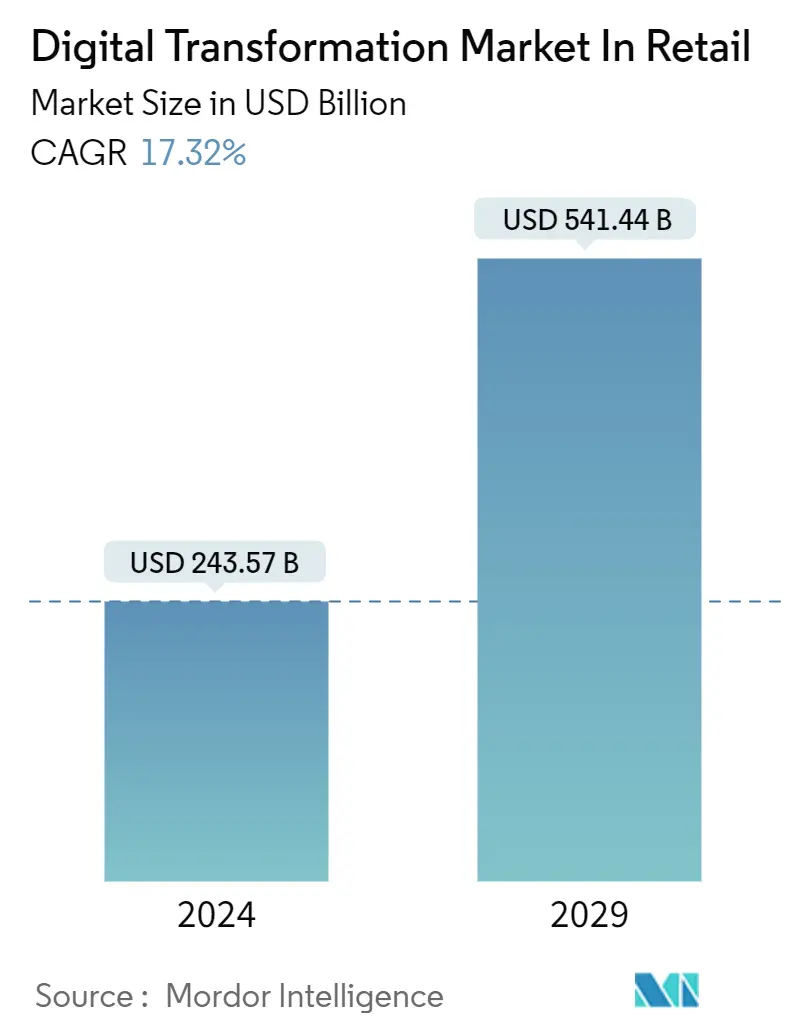
| Study Period | 2019 - 2029 |
| Market Size (2024) | USD 243.57 Billion |
| Market Size (2029) | USD 541.44 Billion |
| CAGR (2024 - 2029) | 17.32 % |
| Fastest Growing Market | Asia Pacific |
| Largest Market | North America |
Major Players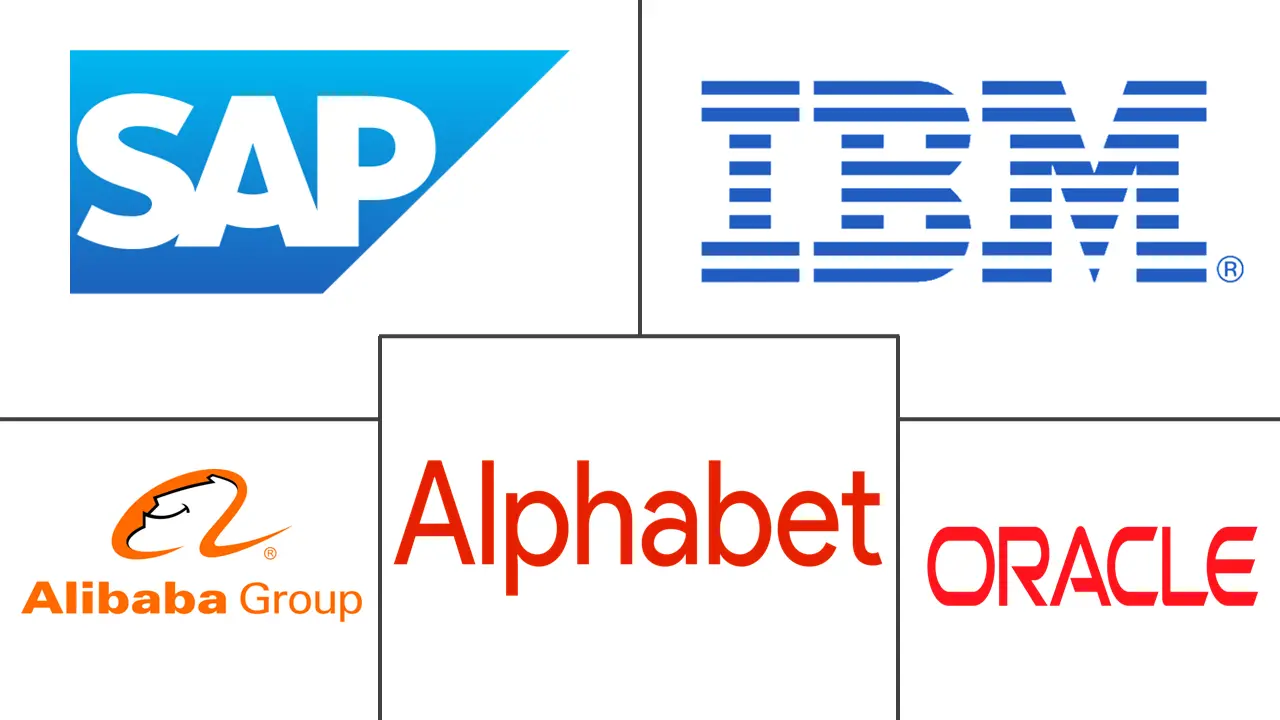
*Disclaimer: Major Players sorted in no particular order |
Need a report that reflects how COVID-19 has impacted this market and its growth?
Retail Industry Digital Transformation Market Analysis
The Digital Transformation Market In Retail Industry is expected to grow from USD 243.57 billion in 2024 to USD 541.44 billion by 2029, at a CAGR of 17.32% during the forecast period (2024-2029).
- The advent of digital technologies for collecting, storing, analyzing, and distributing information has created new dynamics in the digital transformation of the retail market. These digital technologies also raised numerous new opportunities for vendors serving the market as an organization requires an efficient and easy work process owing to the increase in worldwide liberal trade policies and end-users.
- Rapidly increasing internet penetration is a key factor contributing to the market's growth over the forecast period. An increase in smart gadgets and incremental technological advancements will pave the way for growth in this market by making this technology more accessible to small/medium-scale retail organizations. For instance, according to ITU 2022 report, internet users globally increased from 3,217 million in 2016 to 4,901 million in 2021.
- Customers' rising demands are pushing merchants to form strategic alliances with technology suppliers in order to capitalize on new prospects. These collaborations enable merchants to improve their technological competence and offer value to their operations. Retailers are progressively cooperating with tech suppliers to develop the most appropriate and long-term business solutions, which have contributed to market growth.
- For instance, recently, Macy's, Inc. revealed intentions to develop a curated online marketplace in order to expand the company's current influence as a digitally driven omnichannel retailer. By allowing carefully chosen third-party retailers to offer their items on macys.com and bloomingdales.com, the expanded marketplace will dramatically increase the company's inventory in established areas and brands while also introducing a variety of new regions.
- The outbreak of COVID-19 had a favorable influence on industry development throughout and after the outbreak. The demand to improve operational productivity is significantly fuelling the development of the digital transformation industry. Furthermore, the pandemic has boosted the growth of the retail e-commerce industry as consumers tend to purchase more retail products from e-commerce websites to prevent them from getting infected.
- Numerous shops focus on incorporating modern technology, including big data and AI, to help their company develop. Furthermore, a significant challenge they encounter is a need for more in-house competencies and knowledge. Employing IT expertise is challenging since leading technology businesses are competing for the finest people. These factors are expected to create obstacles to market growth over the coming years.
Retail Industry Digital Transformation Market Trends
Beauty and Personal Care to Hold Significant Share
- The retail industry has witnessed tremendous growth in developed countries, such as China, the US, the UK, Japan, and Germany (followed by others), which are capturing the lion's share. People in the age group of 18-50 years are continuously engaged in shopping, thus contributing to the growth of the beauty and personal care segment. All these trends together offer a platform for growth for the beauty and personal care market.
- Consumers are able to pay more significant consideration to their hygiene, health, and appearance as their level of living has improved. As a result, the beauty and personal care goods industry is among the most popular destinations for them to purchase. This also gives personal care firms a better possibility to expand and capitalize on expanding market prospects.
- Owing to the increased penetration of technology among various age groups across the countries, the retail domain has become an integral part of cosmetic products. Free returns and comprehensive delivery options are focused on by retailers, adding value to the segment. Retail outlets continue to expand their product line (ranging from hair care, body care, face care, alcoholic perfumery, and hygiene products) with specifications and effective price comparisons being provided to the consumers.
- In recent years, e-commerce channels have changed the cosmetics sector. E-commerce websites typically provide additional deals, enticing people to buy recognized beauty goods online. Furthermore, these platforms provide convenience and a better buying experience, among other advantages.
- Growing internet usage and targeted marketing by businesses to reach a larger audience has supported category growth. Furthermore, significant discounts and offers made available by online platforms would promote the demand for beauty and personal care goods worldwide. Moreover, the rise of direct-to-consumer firms, the impact of digital influencers, and the increasing complexity of beauty technologies that gives product suggestions fuel e-commerce revenues of skin care and color cosmetics. Thus, the shift of consumer trends toward only shopping has compelled existing companies to adopt digital technologies to maintain a competitive edge.
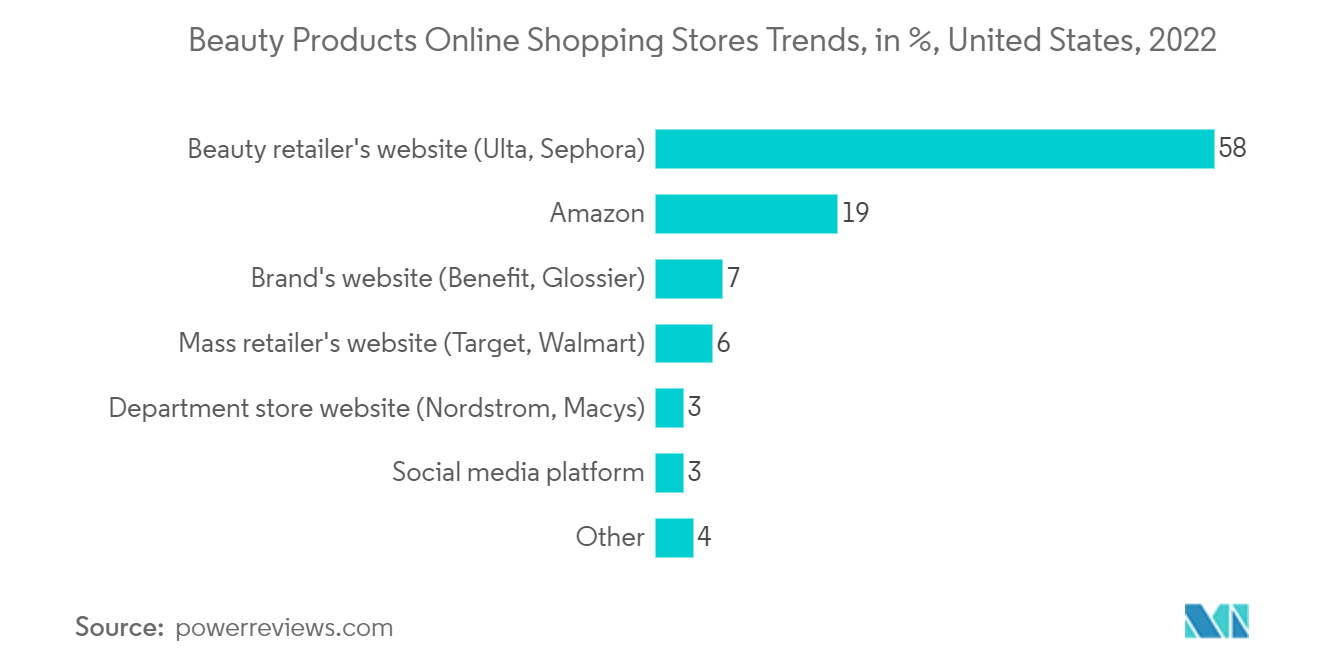
North America Expected to have Highest Market Share
- North America is expected to garner a significant share due to the rapid increase in small and medium-sized enterprises and the continuous expansion of the service industry. Online shopping is growing in the region, with more and more retailers coming onto the internet to sell their products. To sustain the intense industry competition, many retailers seek to provide a personalized experience for which they employ retail analytics.
- The region's retail market is growing fast, with retail manufacturing accounting for more than 10% of the GDP in both the United States and Canada. The retail market in North America is one of the biggest, with Wal-Mart, Costco, Kroger, Home Depot, and Target originating in this region.
- Furthermore, the e-commerce industry in the region is seeing rapid expansion. As per the US Census Bureau, overall e-commerce retail revenues in North America climbed by 7.8% in the initial quarter of 2021 as opposed to the first quarter of 2020, reaching USD 1,581.4 billion. Customers prefer online shopping to in-store shopping because of the lower prices and buying convenience. This, in turn, has boosted investments in the retail industry's digital transformation, contributing to market growth.
- For instance, in September 2022, Cigniti Technologies, the world's foremost AI and IP-led Digital Verification and Digital Development services provider, deepened its engagement with a big American retailer by providing superior digital service to its consumers and advancing its digital aspirations.
- The United States contributes the most to developing the retail e-commerce industry and generates the most prospects for e-commerce retailing business participants, trailed by Mexico. The United States has an extensive infrastructure, a growing number of smartphone subscribers, online retailers, and other internet shopping sites. For instance, In January 2021, there were approximately 298.8 million web subscribers in the United States of America, based on Datareportal 2021. Between 2020 and 2021, the population of internet subscribers in the United States of America rose by 11 million (3.7%). This has boosted digital retail trends and is expected to increase over the forecast period.
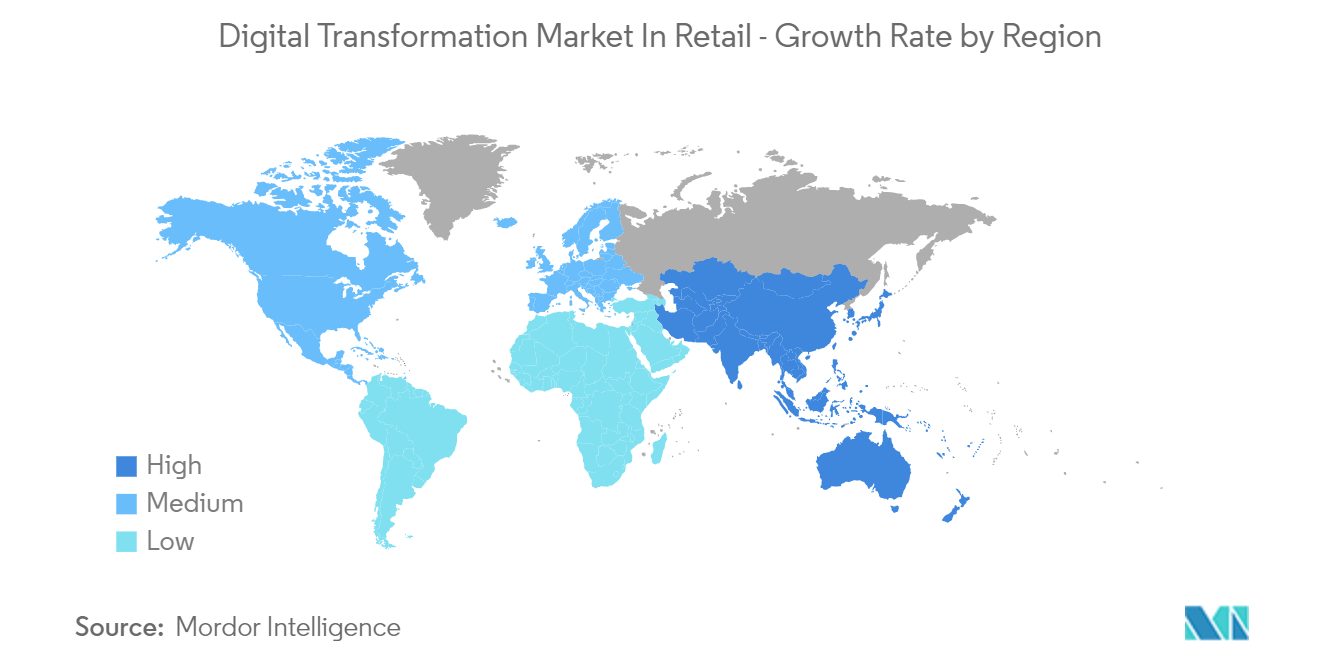
Retail Industry Digital Transformation Industry Overview
Digital transformation in the retail market is moderately competitive due to the presence of numerous players who are continuously investing in R&D and innovation in digital transformation tools to attract a large number of players. Some major players operating in the market include SAP SE, IBM Corporation, Alphabet Inc., Oracle Corporation, and Alibaba Group Holding Ltd.
In August 2022, Globant, a digitally native business focused on changing organizations via creative digital solutions, launched its Retail Studio. Globant's new solution aims to assist retailers in remaining ahead of industry developments by providing tools for total supply chain transparency and automation and redefining retail via phygital interactions that increase consumer engagement.
In February 2022, Inmar Intelligence, an industrial data technology firm, revealed that Smart & Final, a groceries store retailer, is employing Inmar Intelligence's promotional tools to deliver targetable and traceable digital discounts and offsite media. Inmar will be responsible for reward, offsite marketing targeting, and execution, including measurement.
Retail Industry Digital Transformation Market Leaders
SAP SE
IBM Corporation
Oracle Corporation
Alibaba Group Holding Ltd
Alphabet Inc.
*Disclaimer: Major Players sorted in no particular order
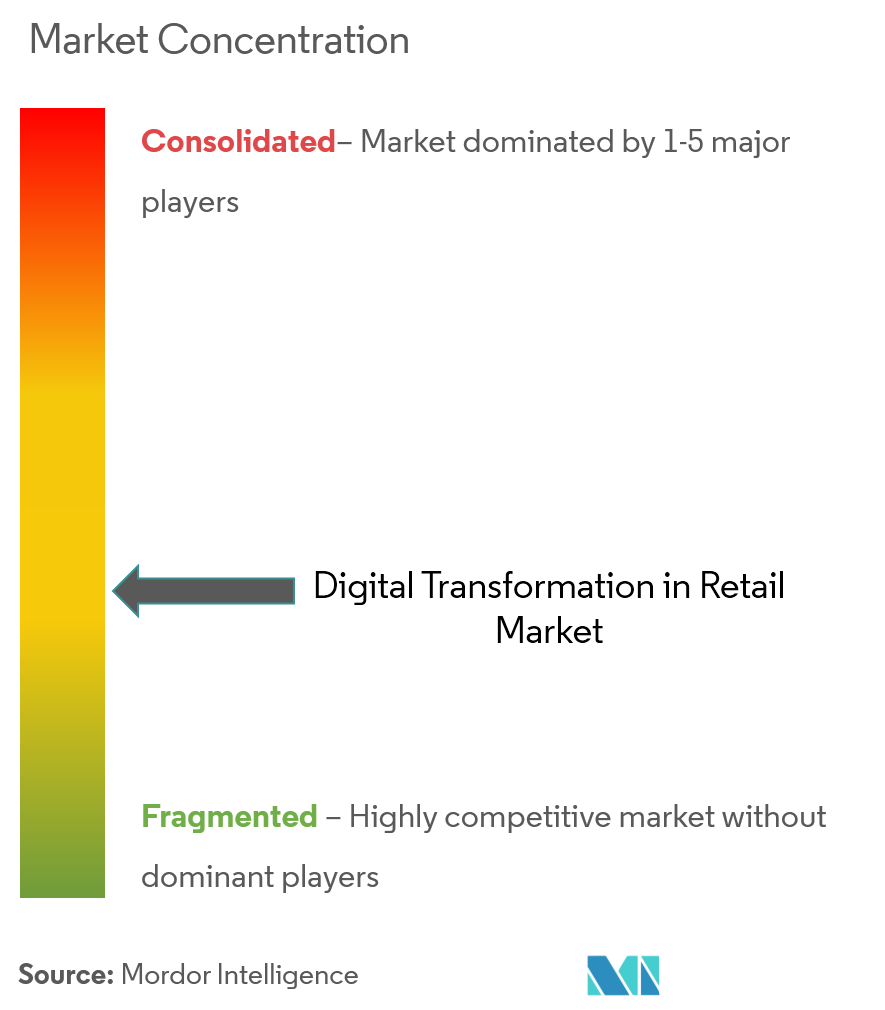
Retail Industry Digital Transformation Market News
- September 2022: Boots announced the introduction of a unique online store in 2023 as part of its digital transformation strategy. Boots's marketplace goods will be easily linked with the established product selection on boots.com, providing users access to hundreds of brands from known companies and new vendors.
- June 2022: HCL Technologies (HCL) introduced Industry NeXT, a transformative framework to assist clients in digitally reinventing their enterprises. HCL Technologies' Industry NeXT platform is built on the Industry 4.0 (I4.0) framework and helps organizations worldwide to plan, prepare, and effortlessly transition into a cooperative environment.
- April 2022: Primark launched its website, the next milestone in its digital strategy. The website marks a transition in the importance of digital inside the company, recognizing the vital function the internet can play in supporting in-store sales.
- March 2022: Informatica, the corporate cloud data administration pioneer, introduced the Intelligent Data Management Cloud (IDMC) for retail, which includes novel cloud-first, cloud-native features designed to assist the retail sector create innovations and commercial value by addressing particular obstacles such as data fragmentation, information complexity, including a lack of linked interactions in a multi-cloud, mixed environment.
- January 2022: Toshiba Global Commerce Systems unveiled a significant extension of its next-generation ELERATM integrated commerce platform to speed up retailer digital transition at the National Retail Federation Conference. The growth heralds a revolutionary generation of retail technology that is nimble, networked, and infinitely adjustable.
Retail Industry Digital Transformation Market Report - Table of Contents
1. INTRODUCTION
1.1 Study Assumptions and Market Definition
1.2 Scope of the Study
2. RESEARCH METHODOLOGY
3. EXECUTIVE SUMMARY
4. MARKET DYNAMICS
4.1 Market Overview
4.2 Market Drivers
4.2.1 Increased Usage of Smart Devices
4.2.2 Growing Need for Advanced Mobile Logistics Management
4.2.3 Demand for Increase in the Yield and Efficiency
4.3 Market Restraints
4.3.1 Lack of General Awareness and Expertise in Emerging Regions
4.3.2 Standardization and Integration Issues
4.4 Industry Attractiveness - Porter's Five Forces Analysis
4.4.1 Threat of New Entrants
4.4.2 Bargaining Power of Buyers
4.4.3 Bargaining Power of Suppliers
4.4.4 Threat of Substitute Products
4.4.5 Intensity of Competitive Rivalry
5. MARKET SEGMENTATION
5.1 By Accesibility
5.1.1 Mobile Application
5.1.2 Website
5.2 By Product
5.2.1 Consumer Electronics
5.2.2 Media and Entertainment
5.2.3 Apparel
5.2.4 Food and Beverage
5.2.5 Furniture and Home Decor
5.2.6 Beauty and Personal Care
5.2.7 Other Products
5.3 By Technology
5.3.1 Cloud computing
5.3.2 Big data
5.3.3 AI
5.3.4 IoT
5.3.5 AR/VR
5.4 Geography
5.4.1 North America
5.4.1.1 United States
5.4.1.2 Canada
5.4.2 Europe
5.4.2.1 United Kingdom
5.4.2.2 France
5.4.2.3 Germany
5.4.2.4 Rest of Europe
5.4.3 Asia Pacific
5.4.3.1 China
5.4.3.2 Japan
5.4.3.3 India
5.4.3.4 Rest of Asia-Pacific
5.4.4 Latin America
5.4.4.1 Mexico
5.4.4.2 Brazil
5.4.4.3 Argentina
5.4.4.4 Rest of Latin America
5.4.5 Middle East & Africa
5.4.5.1 United Arab Emirates
5.4.5.2 Saudi Arabia
5.4.5.3 Rest of Middle East & Africa
6. COMPETITIVE LANDSCAPE
6.1 Company Profiles
6.1.1 SAP SE
6.1.2 IBM Corporation
6.1.3 Alphabet Inc.
6.1.4 Oracle Corporation
6.1.5 Alibaba Group Holding Ltd
6.1.6 Accenture Plc
6.1.7 Capgemini Service SAS
6.1.8 Honeywell International Inc.
6.1.9 Flipkart Inc.
6.1.10 Amazon.com Inc.
- *List Not Exhaustive
7. INVESTMENT ANALYSIS
8. MARKET OPPORTUNITIES AND FUTURE TRENDS
Retail Industry Digital Transformation Industry Segmentation
Digital Transformation is a movement from point solutions that deliver incremental value to integrated process and technology solutions that provide transformational outcomes in terms of Business Efficiency, Customer Experience, and/or Business Innovation. The Digital Transformation Market in Retail is segmented by Accessibility (Mobile Application, Website), Products (Consumer Electronics, Media and Entertainment, Apparel), Technology (Cloud computing, Big data, AI, IoT, AR/VR), and Geography (North America, Europe, Asia Pacific, Latin America, Middle East & Africa). The market sizes and forecasts are provided in terms of value (USD million) for all the above segments.
| By Accesibility | |
| Mobile Application | |
| Website |
| By Product | |
| Consumer Electronics | |
| Media and Entertainment | |
| Apparel | |
| Food and Beverage | |
| Furniture and Home Decor | |
| Beauty and Personal Care | |
| Other Products |
| By Technology | |
| Cloud computing | |
| Big data | |
| AI | |
| IoT | |
| AR/VR |
| Geography | ||||||
| ||||||
| ||||||
| ||||||
| ||||||
|
Retail Industry Digital Transformation Market Research FAQs
How big is the Retail Digital Transformation Market?
The Retail Digital Transformation Market size is expected to reach USD 243.57 billion in 2024 and grow at a CAGR of 17.32% to reach USD 541.44 billion by 2029.
What is the current Retail Digital Transformation Market size?
In 2024, the Retail Digital Transformation Market size is expected to reach USD 243.57 billion.
Who are the key players in Retail Digital Transformation Market?
SAP SE, IBM Corporation, Oracle Corporation, Alibaba Group Holding Ltd and Alphabet Inc. are the major companies operating in the Retail Digital Transformation Market.
Which is the fastest growing region in Retail Digital Transformation Market?
Asia Pacific is estimated to grow at the highest CAGR over the forecast period (2024-2029).
Which region has the biggest share in Retail Digital Transformation Market?
In 2024, the North America accounts for the largest market share in Retail Digital Transformation Market.
What years does this Retail Digital Transformation Market cover, and what was the market size in 2023?
In 2023, the Retail Digital Transformation Market size was estimated at USD 201.38 billion. The report covers the Retail Digital Transformation Market historical market size for years: 2019, 2020, 2021, 2022 and 2023. The report also forecasts the Retail Digital Transformation Market size for years: 2024, 2025, 2026, 2027, 2028 and 2029.
Retail Digital Transformation Industry Report
Digital Transformation in Retail is creating new dynamics and opportunities in the market, driven by the advent of digital technologies for collecting, storing, analyzing, and distributing information. The rise in internet penetration and the increase in smart gadgets are making this technology more accessible to small and medium-scale retail organizations. Retail Industry Digital Transformation is seeing retailers forming strategic alliances with technology suppliers to capitalize on new prospects and improve their technological competence. The Transformation of Retail through Digital is segmented by accessibility, products, and technology, with North America expected to hold a significant share due to the rapid increase in small and medium-sized enterprises and the continuous expansion of the service industry. Major players in the Digital Revolution in Retail include SAP SE, IBM Corporation, Alphabet Inc., Oracle Corporation, and Alibaba Group Holding Ltd. For a more detailed analysis of the Retail Sector Digital Transformation, a free PDF download of the report is available. The Digital Change in Retail is expected to continue to evolve, with Retail's Digital Transformation playing a significant role. For a deeper understanding of the Transformation in Retail Digitalization, the report provides comprehensive insights. The Digital Shift in Retail is a significant factor in the current market scenario, and the Retail Transformation via Digital is expected to shape the future of the industry.
